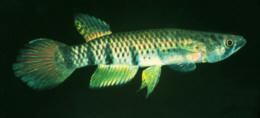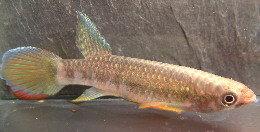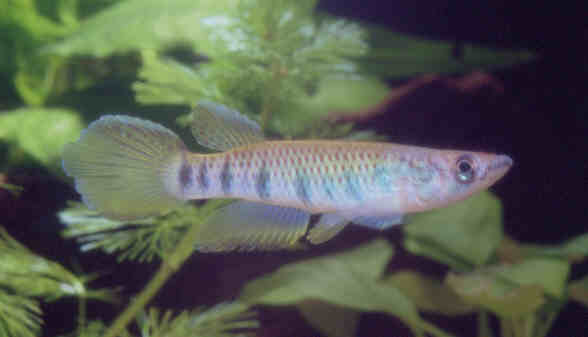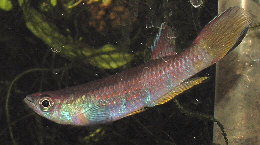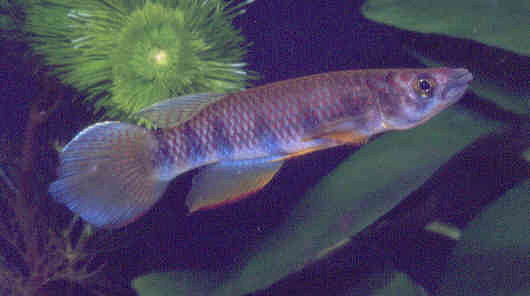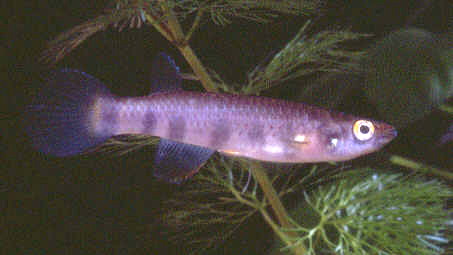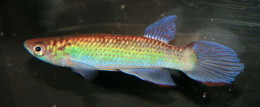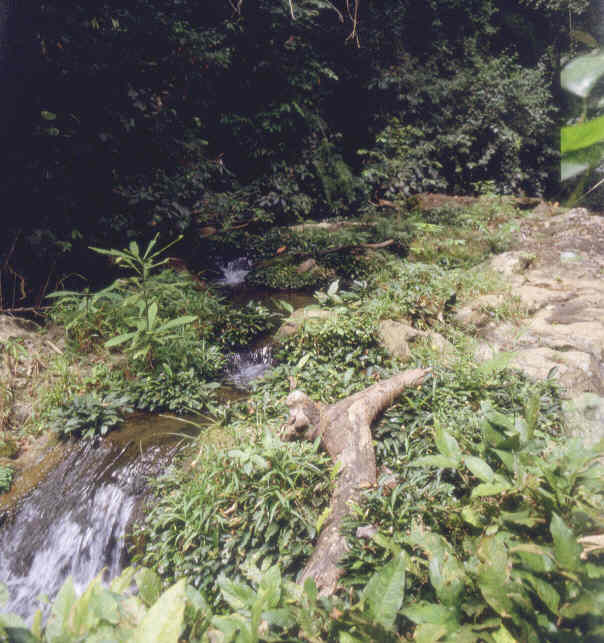Epiplatys sexfasciatus Gill 1862
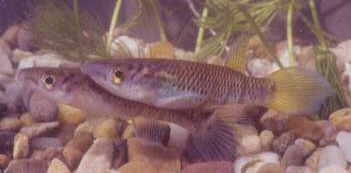
Wild pair found in a commercial import from Lagos.
| Meaning of Name |
Refers to the 6 dark bands along the body. |
||||||||||||
| First Description |
Gill T. 1862. On the west African genus Hemichromis and description of new species in the museum of the Academy and Smithsonian Institution. Proceedings of the Academy of Natural Sciences of Philadelphia 14: 136 (footnote). |
||||||||||||
| Size |
10 cm (Scheel 1990, Atlas). |
||||||||||||
| Meristics |
|
||||||||||||
| Karyotype |
n = 24, A = 25 (Scheel 1974, 1990). |
||||||||||||
| Sub-Genus |
Epiplatys |
||||||||||||
| Group |
sexfasciatus |
||||||||||||
| Synonyms |
|
||||||||||||
Populations
|
Akkamkpa - Introduced into the BKA & bred. Known to have been here in 2005. Andem - BDBG 04 / 2 location was described as being 'beautiful yellow & blue'. Difficulties in breeding & maintenance saw them dissapear from the hobby around 2008. Barombi - A crater lake near Kumba. Scheel studied this population & noted it as being 'variable'. Collected originally on the shores of Lake Barombi by Mr.Birket Smith in 1959, who was collecting butterflies at the time. No aquatic vegetation was noted at this biotope. See BKA newsletter 11 & 12. Benin City - Collected by Ulf Hannerz of Sweden in 1962 near Benin City, southern Nigeria. He gave 3 forms of Epiplatys to Scheel for identification. One form was identified by Scheel as sexfasciatus who had 2 males & 3 females as breeding stock. Females exhibited a dark longitudinal band when spawning. He reported 'One of the males has an overall yellow brilliance & even the pectorals are bright yellow' Coco Beach - Collected by Hofmann & Pürzl in the 1980's. Reportedly only slight difference from the 1980 Pap collection.
Ibadan - Collected by the Zoologist Birkett-Smith in 1959-60 at the Botanic Garden of Ibadan, the University of Lagos, Nigeria. The base colour was reportedly 'cold grey' according to Scheel (BKA newsletter August 1966). Females used for spawning did not exhibit any dark longitudinal banding. See also E.infrafasciatus Barombi population.. Machinda - Near Bata, Equatorial Guinee. Collected 2003 - GEMLBJ 03 / 47.
|
||||||||||||
| Type Locality |
Given as 'Gaboon River'. |
||||||||||||
| Distribution |
Northwestern Gabon northwards just into Equatorial Guinea. They inhabit the lower Komo, Ogowe River drainage systems & the Estuary of Gabon. http://homepage.uibk.ac.at/homepage/c102/c102mr/epiplaty/sexfasci.htm |
||||||||||||
| Habitat |
Small Rivers, streams, pools & swamps.
Biotope of E.sexfasciatus
at Cocobeach, Gabon. See A.ahli for another biotope photo. |
||||||||||||
| Distinguishing Characteristics | Scheel in ROTOW 1 reported that males collected in the Niger Delta & areas to the west up to the Togo Hills, Ghana have long pointed ventral fins. These individuals can be mistaken for E.longiventralis. Populations collected to the east of the Delta through Cameroon to Gabon have rounded ventral. | ||||||||||||
| Colour/Pattern Variability | Fairly high. | ||||||||||||
| History |
Described by Gill in 1862 from 'numerous specimens'
collected in Gabon. This description was not very informative &
Boulenger redescribed them in 1915. The material used in this redescription
also contained individuals of chaperi,
multifasciatus & macrostigma.
Keilhack also redescribed them from a mixture of sp. in 1910. Boulenger gives the following collectors / locations in his 1915 Catalogue.
In 1930 Fowler prepared a full redescription from Gill's 30 cotypes. Collected by M.Birket Smith in various locations in 1959 - Ibadan, Lake Barombi. In 1962 Ulf Hannerz collected near Benin City. The BKA received a wild shipment from Cameroon containing E.sexfasciatus. Unknown date. |
||||||||||||
| Breeding Notes |
Regarded as more of a challenge than others in the genus. They will lay eggs in fine leaved plants & spawning mops but they are not a prolific species. Eggs water incubate for 12-14 days. With such a large fish growth is slow with sexual maturity taking 7-8 months. |
||||||||||||
| Diameter of Egg | |||||||||||||
| Remarks |
Some authors prefer to lump E.sexfasciatus & E.infrafasciatus together whilst others prefer to split them. I have given information on each species. |
